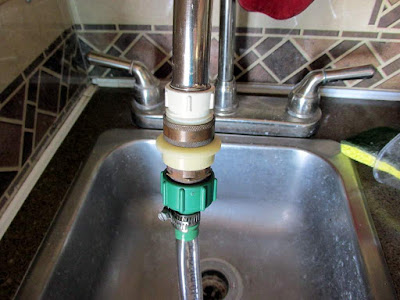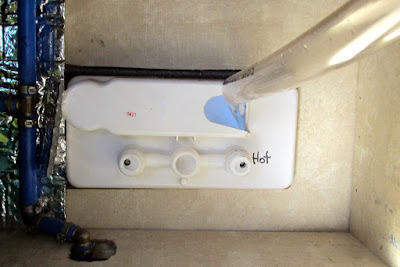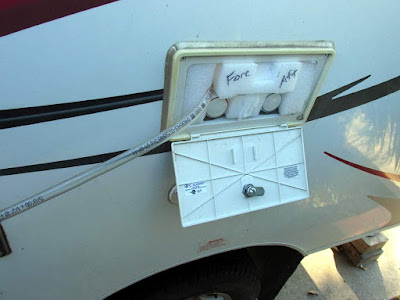profdant139
Nov 30, 2015Explorer II
Manual water tank heater hose: see update in first post
(Update -- this simple device really works in the real world. We just spent a week in Yosemite where it did not get above freezing for four days in a row -- and the water lines did not freeze! It was in the teens every night. We ran the recirculating hose once in the afternoon, once in the evening, once before bed, once in the middle of the night, and once in the morning. We had plenty of propane, and the pump did not come close to draining the battery -- using our 120 watt solar panel, the battery never dropped below 12.4 volts at any time. We also ran our Honda 2000 generator for 90 minutes one afternoon, something we have not done in several years.
A few tips -- when you set up your hose, make sure that whenever you disconnect it from the faucet, gravity will completely drain the hose into the fill pipe -- otherwise the hose will freeze. And make sure that there is a swivel on the attachment between the hose and the faucet -- it makes it easier to hook the hose up and to detach it.
Bottom line -- if you have an outdoor shower door, this crude method really works if you do a few days of winter camping. If you do a lot of winter camping, a more sophisticated automatic recirculating mechanism would be preferable. And now, back to the original posting!)
During our last trip to Sequoia, the outlet hose leading from the water tank to the pump froze one night, when the temp got down to 11 degrees. After some helpful discussions on this forum, I rigged up this simple solution:
A hose connects to the water faucet. The hose runs to the outside through the outdoor shower opening. The hose runs along the outside wall of the trailer, and the end goes into the external fill pipe of the water tank. Right before bedtime, we run a few gallons of hot water, and the temp of the tank is substantially increased. The warmed-up water runs through the outlet hose and back to the pump.
This solution is so simple, crude, and obvious that I am almost ashamed to post pictures of it -- but here we go anyway. This is the end that screws onto the faucet – I have included a swivel fitting to make it easier to attach:

Here it is attached to the faucet:

The hose runs over the edge of the sink, under the counter, and into the opening for the outdoor shower:

This is a view of the hose as it passes through the outdoor shower opening:

(The word "hot" was written by whoever installed the outdoor shower at the factory.)
This is an exterior view, showing the hose emerging from the outdoor shower opening – as you can see, I have also inserted blocks of tightly-fitting closed-cell foam blocks into the outdoor shower fixture as extra insulation:

And here is the hose going into the external fill pipe door:

For storage, the whole thing coils up and goes into an under-seat storage bin.
Some thoughts and caveats:
A thermostatically controlled built-in under-counter system would be far better. But it requires cutting into the plumbing, and some electrical work. My solution is crude but effective -- very simple and inexpensive. It does the job, especially if (like us) you rarely camp in weather below 20 degrees. (We have camped at 20 many times, with no freeze, but this last trip was just a little too cold.)
Obviously, this solution only works if you have an outside shower fixture -- otherwise, how would you get the hose through the wall? And it is much easier if you have previously removed all of the outdoor shower plumbing fixtures. (We did that when we got the trailer, because it is always too cold for a late afternoon outside shower when we are boondocking. We needed the extra room under the sink more than we needed the shower, since we use the inside shower.)
The main drawback to this system is that it has to be set up whenever you want to use it and then taken down whenever you want to change your campsite. But we so rarely encounter temperatures below 20 that this will be an infrequent event.
The other drawback is that this system does not operate automatically, unlike thermostatically controlled hot water recirculators. So, for example, I plan on running this device at least once during the night, which will mean that when I get up at 3 am (which I always do), I will have to stand there for three minutes while the hot water runs into the fresh water tank. Not a deal-breaker, but not effortless, either. And the water heater will need to stay on during the entire night, which means that it will cycle on and off every few hours, which is a little noisy. Better than frozen pipes, though!
A few tips -- when you set up your hose, make sure that whenever you disconnect it from the faucet, gravity will completely drain the hose into the fill pipe -- otherwise the hose will freeze. And make sure that there is a swivel on the attachment between the hose and the faucet -- it makes it easier to hook the hose up and to detach it.
Bottom line -- if you have an outdoor shower door, this crude method really works if you do a few days of winter camping. If you do a lot of winter camping, a more sophisticated automatic recirculating mechanism would be preferable. And now, back to the original posting!)
During our last trip to Sequoia, the outlet hose leading from the water tank to the pump froze one night, when the temp got down to 11 degrees. After some helpful discussions on this forum, I rigged up this simple solution:
A hose connects to the water faucet. The hose runs to the outside through the outdoor shower opening. The hose runs along the outside wall of the trailer, and the end goes into the external fill pipe of the water tank. Right before bedtime, we run a few gallons of hot water, and the temp of the tank is substantially increased. The warmed-up water runs through the outlet hose and back to the pump.
This solution is so simple, crude, and obvious that I am almost ashamed to post pictures of it -- but here we go anyway. This is the end that screws onto the faucet – I have included a swivel fitting to make it easier to attach:
Here it is attached to the faucet:
The hose runs over the edge of the sink, under the counter, and into the opening for the outdoor shower:
This is a view of the hose as it passes through the outdoor shower opening:
(The word "hot" was written by whoever installed the outdoor shower at the factory.)
This is an exterior view, showing the hose emerging from the outdoor shower opening – as you can see, I have also inserted blocks of tightly-fitting closed-cell foam blocks into the outdoor shower fixture as extra insulation:
And here is the hose going into the external fill pipe door:
For storage, the whole thing coils up and goes into an under-seat storage bin.
Some thoughts and caveats:
A thermostatically controlled built-in under-counter system would be far better. But it requires cutting into the plumbing, and some electrical work. My solution is crude but effective -- very simple and inexpensive. It does the job, especially if (like us) you rarely camp in weather below 20 degrees. (We have camped at 20 many times, with no freeze, but this last trip was just a little too cold.)
Obviously, this solution only works if you have an outside shower fixture -- otherwise, how would you get the hose through the wall? And it is much easier if you have previously removed all of the outdoor shower plumbing fixtures. (We did that when we got the trailer, because it is always too cold for a late afternoon outside shower when we are boondocking. We needed the extra room under the sink more than we needed the shower, since we use the inside shower.)
The main drawback to this system is that it has to be set up whenever you want to use it and then taken down whenever you want to change your campsite. But we so rarely encounter temperatures below 20 that this will be an infrequent event.
The other drawback is that this system does not operate automatically, unlike thermostatically controlled hot water recirculators. So, for example, I plan on running this device at least once during the night, which will mean that when I get up at 3 am (which I always do), I will have to stand there for three minutes while the hot water runs into the fresh water tank. Not a deal-breaker, but not effortless, either. And the water heater will need to stay on during the entire night, which means that it will cycle on and off every few hours, which is a little noisy. Better than frozen pipes, though!